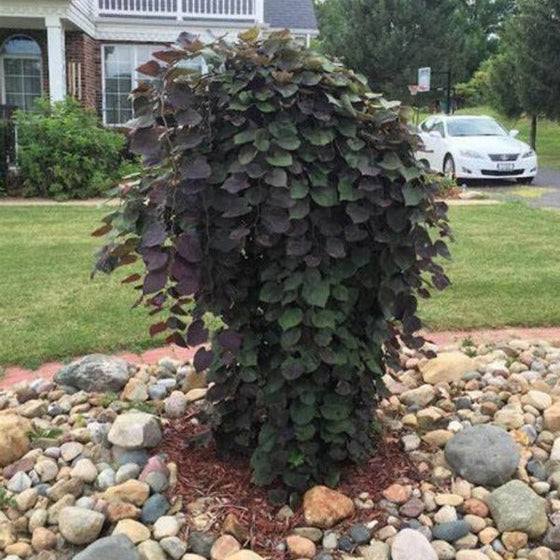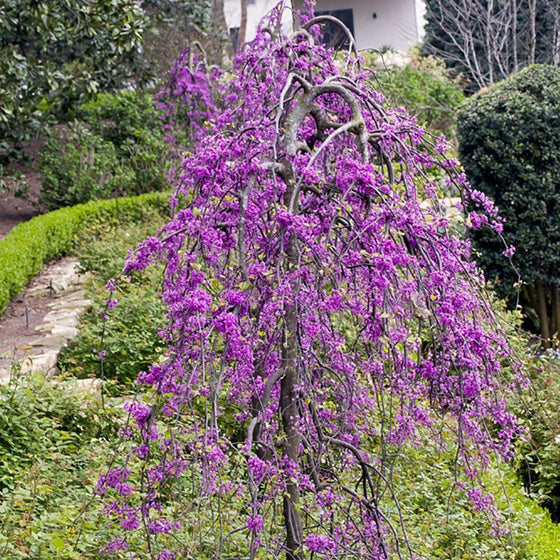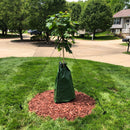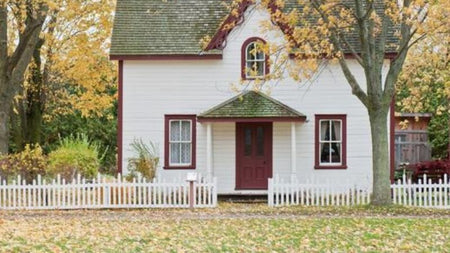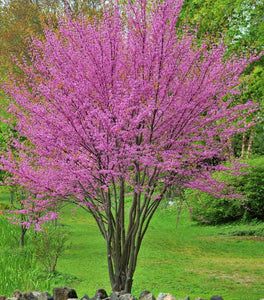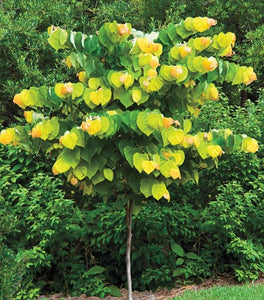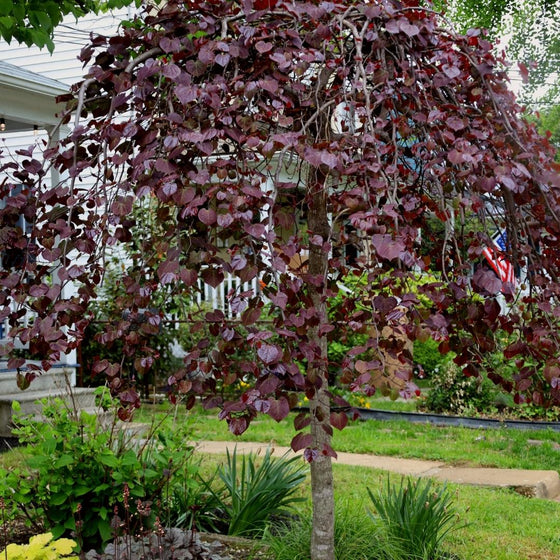
Images Depict Mature Plants
Ruby Falls Redbud Trees for Sale Online
The Ruby Falls Redbud Tree (Cercis canadensis ‘Ruby Falls’) is a striking ornamental tree known for its weeping habit, bold heart-shaped foliage, and stunning spring blooms. This compact, cascading redbud produces vibrant, rosy-purple flowers that bloom profusely along its graceful, arching branches in early spring—often before the leaves emerge—creating a dramatic fountain of color in the landscape. As the season progresses, its rich burgundy to deep purple foliage adds a second wave of interest, standing out beautifully against green backdrops and brighter blooms.
Reaching a mature height of just 6 to 8 feet with a similar spread, the Ruby Falls Redbud is ideal for small gardens, urban landscapes, or as a standout specimen tree in mixed beds. Its unique weeping form brings elegance and architectural interest to the landscape, while its manageable size makes it perfect for focal points near patios, walkways, or entryways. Hardy in USDA Zones 5–9, this tree thrives in full sun to partial shade and prefers well-drained soil. Once established, it is drought-tolerant and relatively low-maintenance, making it a smart choice for homeowners and landscape designers alike.
In addition to its showy appearance, the Ruby Falls Redbud Tree attracts pollinators like bees and butterflies with its early spring blooms, supporting the health of your local ecosystem. Its year-round appeal—from floral display to colorful foliage and graceful structure—ensures it remains a centerpiece in the garden through all seasons. Whether you're designing a contemporary landscape or a cottage garden, Ruby Falls Redbud delivers rich color, sculptural beauty, and ornamental value in one compact, eye-catching tree.
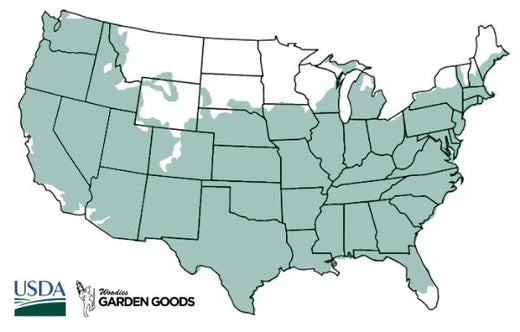
| Hardiness Zone: | 5-9 |
|---|---|
| Mature Height: | 5 to 6 Feet |
| Mature Width: | 3 to 4 Feet |
| Classification: | Broad leaved deciduous flowering tree |
| Sunlight: | Full sun to partial shade |
| Habit: | Upright, weeping |
| Foliage: | Burgundy |
| Flower Color: | Pink |
| Pruning Season: | Late spring after flowering |
| Soil Condition: | Any well drained soil |
| Water Requirements: | Water well until established |
| Uses: | Tolerates moist soil and full sun. Full sun brings out the best fall color. Will adapt to drier sites |
How to Care for Ruby Falls Redbud
Be sure to read our planting instructions to ensure a healthy and happy Ruby Falls Redbud Tree for years to come!
How Do I Plant a Ruby Falls Redbud Tree?
To plant a Ruby Falls Redbud Tree (Cercis canadensis ‘Ruby Falls’), begin by selecting a site with full sun to partial shade—at least 4 to 6 hours of direct sunlight daily ensures vibrant blooms and rich foliage color. This compact weeping redbud prefers well-drained soil that is slightly acidic to neutral, and it's important to avoid areas where water tends to collect, as overly wet roots can lead to root rot. Dig a hole twice as wide and the same depth as the tree’s root ball to allow for proper root expansion. Place the tree in the hole with the root flare (where the trunk meets the roots) at soil level, backfill with native soil, and water deeply to eliminate air pockets. After planting, apply a 2- to 3-inch layer of mulch around the base of the Ruby Falls Redbud Tree, keeping it a few inches away from the trunk to prevent rot. Mulch helps retain moisture, suppress weeds, and protect roots from temperature extremes. During the first growing season, water the tree regularly to keep the soil evenly moist, especially during dry spells. Once established, this redbud is moderately drought-tolerant and low-maintenance. Its compact size and elegant, cascading form make it ideal for planting near patios, walkways, or as a standout specimen in mixed beds and foundation plantings. Proper planting sets the stage for years of cascading blooms, colorful foliage, and ornamental charm.
How Do I water a Ruby Falls Redbud Tree?
Watering a Ruby Falls Redbud Tree (Cercis canadensis ‘Ruby Falls’) properly is key to establishing a healthy root system and ensuring vibrant growth. During the first growing season, water deeply once or twice a week, allowing the soil to dry slightly between waterings. Deep watering encourages roots to grow downward, making the tree more resilient during dry periods. Focus water at the base of the tree and avoid overhead watering, which can promote fungal diseases. The goal is to keep the soil evenly moist—but never soggy—especially in the critical weeks following planting. Once established, the Ruby Falls Redbud becomes more drought-tolerant and typically only needs supplemental watering during prolonged dry spells or extreme heat. Check the soil moisture regularly; if the top 2 inches of soil feel dry, it's time to water. Applying a 2- to 3-inch layer of mulch around the base of the tree helps retain soil moisture and regulate temperature, further reducing the need for frequent watering. By maintaining consistent and appropriate moisture levels, your Ruby Falls Redbud will flourish—rewarding you with cascading spring blooms and rich burgundy foliage throughout the growing season.
How Do I Fertilize a Ruby Falls Redbud Tree?
Fertilizing a Ruby Falls Redbud Tree (Cercis canadensis 'Ruby Falls') helps support healthy growth, abundant spring blooms, and rich burgundy foliage. The best time to fertilize is in early spring just before new growth begins. Use a balanced, slow-release fertilizer with an N-P-K ratio such as 10-10-10 or 12-4-8, and apply it evenly around the drip line of the tree—this is where the feeder roots are most active. Avoid applying fertilizer too close to the trunk, as this can cause root burn. Water thoroughly after fertilizing to help the nutrients absorb into the soil and reach the roots effectively. If you prefer an organic approach, compost or well-aged manure can be used as a natural fertilizer to enrich the soil and promote steady, sustainable growth. For mature trees, fertilization may only be needed every other year, especially if the soil is naturally rich. Avoid over-fertilizing, as excessive nitrogen can lead to leggy growth and fewer blooms. With the right nutrient support, your Ruby Falls Redbud will continue to thrive, producing vibrant rosy-purple spring flowers followed by cascading heart-shaped leaves in a deep burgundy hue—perfect for creating a standout focal point in your landscape.

How and When should I Prune a Ruby Falls redbud Tree?
Pruning a Ruby Falls Redbud Tree (Cercis canadensis ‘Ruby Falls’) should be done with care to maintain its naturally elegant, weeping form and overall health. The best time to prune is in late winter to early spring, before new growth begins but after the risk of severe cold has passed. Start by removing any dead, damaged, or diseased branches using clean, sharp pruning shears. Then, thin out any crossing or crowded branches in the canopy to improve air circulation and allow sunlight to reach the inner parts of the tree. This selective pruning helps reduce the risk of pests and fungal issues while enhancing the tree’s graceful silhouette. Because of its weeping habit, it’s important not to over-prune a Ruby Falls Redbud, as doing so can alter its distinctive cascading shape. Light shaping can be done after the tree finishes blooming in spring if needed, but always avoid cutting into the main leader or removing too much at once. Focus on encouraging a balanced structure with evenly spaced, arching branches. With proper timing and a gentle approach, pruning keeps your Ruby Falls Redbud healthy and visually stunning—highlighting its rich burgundy foliage and eye-catching, pendulous form in any garden or landscape setting.

